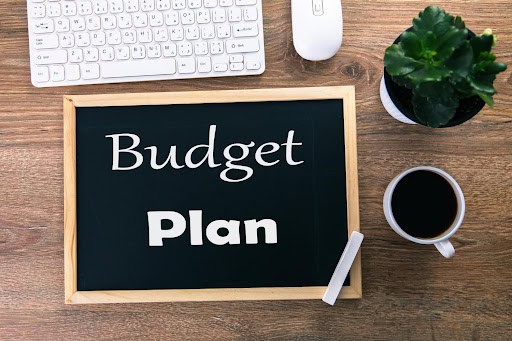Feeling like your money is constantly slipping through your fingers? You’re not alone. Many people struggle to keep track of their income and expenses, leading to financial stress and a lack of progress towards their goals. But there’s a powerful tool at your disposal: the budget planner.
A budget planner is your roadmap to financial freedom. It helps you understand where your money goes, identify areas to save, and make informed spending decisions. Whether you prefer a simple pen-and-paper approach or a digital budgeting app, this guide will equip you with the knowledge and steps to take control of your finances using a budget planner.
Why Budget? The Power of Planning
Creating a budget isn’t just about restricting yourself. It’s about gaining awareness and making conscious choices about your money. Here are some key benefits of using a budget planner:
- See the Big Picture: A budget gives you a clear snapshot of your income and expenses. You’ll see exactly how much money comes in and where it goes, allowing you to identify spending patterns and potential areas for improvement.
- Prioritize Goals: With a budget, you can allocate funds towards your financial goals, whether it’s saving for a down payment on a house, paying off debt, or building an emergency fund.
- Avoid Overspending: Budgeting helps you stay within your means. By tracking your expenses, you’ll be less likely to overspend on impulse purchases and keep your finances on track.
- Reduce Stress: Financial uncertainty can be a major source of stress. Budgeting alleviates this stress by giving you a sense of control over your money.
- Make Informed Decisions: When faced with a spending decision, a budget helps you assess if it aligns with your financial goals and priorities.
Getting Started: Building Your Budget
Creating a budget can seem daunting at first, but it’s a relatively straightforward process. Here’s what you need to do:
- Gather Information: Collect your bank statements, pay stubs, and receipts for the past few months. This will give you a realistic picture of your income and spending habits.
- Choose Your Budgeting Tool: Decide on your preferred method. Popular options include pen-and-paper budget planners, spreadsheet templates, and budgeting apps. Choose a method that feels convenient and accessible to you.
- Track Your Income: List all your income sources, including salary, wages, side hustles, and any recurring income streams. Be sure to factor in taxes and deductions when calculating your net income (what you take home after taxes).
Categorize Your Expenses
Now comes the crucial step of categorizing your expenses. Here are some common expense categories to get you started:
- Fixed Expenses: These are essential bills that remain relatively constant each month, such as rent/mortgage, utilities, car payments, and minimum debt payments.
- Variable Expenses: These expenses fluctuate month-to-month, including groceries, transportation, entertainment, dining out, and personal care.
- Savings Goals: Allocate a specific amount towards your financial goals, such as retirement savings, emergency fund contributions, or a vacation fund.
- Debt Repayment: If you have debt, include a designated amount for additional debt payments beyond minimums.
Pro Tip: You can further customize your expense categories based on your specific needs. For example, you might have separate categories for clothing, hobbies, or subscriptions.
Filling the Budget Planner: Track Your Spending
Here’s where the rubber meets the road. For a month or two, diligently track all your expenses within your chosen categories. Be honest and include everything, from daily coffee runs to monthly subscriptions.
- Pen-and-Paper: Record your income and expenses in the corresponding categories of your budget planner.
- Spreadsheets: Enter your transactions in a spreadsheet with separate columns for date, payee, category, and amount.
- Budgeting Apps: Many budgeting apps connect directly to your bank accounts, automatically categorizing your transactions.
Analyze and Adapt: Refining Your Budget
After a month or two of tracking, it’s time to analyze your spending. Here’s what to look for:
- Identify Spending Leaks: Are there any categories where you’re consistently exceeding your budget? These are potential areas for reduction.
- Evaluate Fixed Expenses: Can you renegotiate any bills or find cheaper alternatives for services like cable or internet?
- Review Variable Expenses: Are there areas where you can cut back without sacrificing your lifestyle significantly?
- Prioritize Savings Goals: Are you allocating enough towards your savings goals?
Sticking to the Plan: Making Your Budget Work for You
Now that you’ve built and analyzed your budget, the real challenge begins: sticking to it. Here are some tips to help you stay on track:
- Be Realistic: Managing your family budget is essential for financial stability. Don’t set yourself up for failure with unrealistic budget goals. Instead, begin with small, achievable adjustments. Start by tracking your expenses and identifying areas where you can cut back without sacrificing necessities. By gradually tightening your family budget over time, you’ll be better positioned to reach your financial goals and ensure long-term stability for your loved ones.
- Embrace Automation: Set up automatic transfers to savings accounts and bill payments. This removes the temptation to overspend and ensures your bills are paid on time.
- Track Your Progress Regularly: Review your budget weekly or bi-weekly to stay mindful of your spending patterns. Celebrate your successes and identify areas where you might need to adjust such as business marketing, promotion and find how some youtube channels explain about family budgeting.
- Embrace the 50/30/20 Rule: This popular budgeting framework suggests allocating 50% of your income to needs (housing, utilities, groceries), 30% to wants (entertainment, dining out), and 20% to savings and debt repayment. This is a flexible guideline, adjust the percentages based on your financial situation and goals.
- Embrace Cash: For some people, using cash for variable expenses can be a helpful strategy. This creates a tangible limit on how much you can spend in a particular category.
- Find a Budgeting Buddy: Enlist a friend or family member who’s also working on their finances. Sharing your goals and experiences can provide motivation and accountability.
Unexpected Expenses and Course Corrections
Life throws curveballs. Unexpected expenses can derail your budget. Here’s how to handle them:
- Emergency Fund: Aim to build an emergency fund that covers 3-6 months of living expenses to deal with unexpected costs like car repairs or medical bills.
- Review Budget Priorities: If a large expense arises, re-evaluate your budget. You might need to temporarily reduce contributions towards a savings goal or cut back on discretionary spending in other categories.
- Communicate with Creditors: In the case of a significant financial setback, communicate with creditors about potential payment adjustments.
Remember, a budget is a tool to empower you, not restrict you. Don’t be discouraged by occasional slip-ups. Review your budget, make adjustments, and recommit to your financial goals.
Beyond the Basics: Advanced Budgeting Techniques
As you gain comfort with budgeting, consider exploring some advanced techniques to further optimize your finances:
- Zero-Based Budgeting: This method allocates every dollar of your income to a specific expense category or savings goal. This can be a meticulous approach, but it ensures all your income is accounted for.
- Envelope System: This traditional method involves allocating cash to designated envelopes for each spending category. Once the cash in an envelope runs out, your spending in that category stops for the month.
- Sinking Funds: These are dedicated savings accounts for specific goals like holidays, annual bills, or car maintenance. Regularly contribute to these funds to avoid financial strain when these expenses arise.
Conclusion: Your Path to Financial Freedom
Budgeting isn’t about deprivation, it’s about making conscious choices with your money. By utilizing a budget planner, you’ll gain control over your finances, achieve your financial goals, and ultimately achieve financial freedom. Remember, consistency is key. The more you use your budget planner and track your spending, the more comfortable and effective it will become. So, take charge, embrace budgeting, and watch your financial future flourish.


